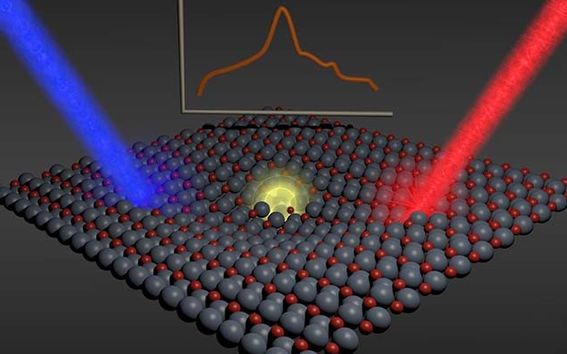Intermediate pseudoparticle sheds light on the energy conversion process

Researchers in Finland and two institutes in Germany have unveiled the existence of a new pseudoparticle that helps explain the conversion of sunlight into energy. A previously unobserved intermediate hole polaron in zinc oxide is believed to be the agent in the light-to-energy conversion process. The better understanding of this polaron and the conversion process could lead to more efficient energy production.
Until recently, these agents were thought be electrons or holes (negatively or positively charged particles, respectively). Polarons emerge when a hole deforms the structure of a material and then travels through it by dragging this deformation along, as seen in the figure above. Taken together, the coupled hole and deformation form a pseudoparticle, the yellow sphere.
In Hikmet Sezen et al’s research, these pseudoparticles were observed in zinc oxide, a photoactive material widely used in sunscreens and touch screens. The photocatalytic process converts energy from sunlight into chemical forms of energy storage and is explored in photovoltaics for the conversion to electrical energy. The stored energy can be saved for later use or used immediately in a device, such as in LEDs.
Experimentalists at Karlsruhe Institute of Technology in Germany used a totally unique experimental setup to discover the new pseudoparticle. They used high energy laser light, seen the blue beam in the figure above, to create polarons in a zinc oxide sample. The polaron and its energy spectrum were then detected with infrared-reflection-absorption spectroscopy with a time resolution of 100 milliseconds. Prof. Christof Wöll exclaimed,
- This polaron had never been observed before in zinc oxide. Yet, we think it plays a crucial role in the light-to-energy conversion process in this material.
Dr. Honghui Shang at the Fritz Haber Institute in Berlin then developed cutting-edge theoretical and computational methodology to categorize this discovery as an intermediate hole polaron.
Collaborator Prof. Patrick Rinke at Aalto University in Finland explains this was not easy to achieve:
- Previously people thought these polarons were either large or small, but after a lot of effort, we correctly interpreted the experimental spectra as a signature of an intermediate polaron.
The research can be now be used to make the light-to-energy conversion process more efficient and thus save – or even generate – more energy. The path to more efficiency might even require the prevention of polaron formation, since dragging a structural deformation through the material costs energy.
The research at Aalto University has been conducted by the Finnish Centre of Excellence in Computational Nanoscience funded by the Academy of Finland.
Their results are being published this week in the journal Nature Communications.
Read more news

Get to know us: Associate Professor Maria Sammalkorpi
Sammalkorpi received her doctorate from Helsinki University of Technology 2004. After her defence, she has worked as a researcher at the Universities of Princeton, Yale and Aalto.
Aalto computer scientists in ICML 2024
Computer scientists in ICML 2024
In low-hierarchy organisations, even key policy issues are discussed in Slack
In a recent study, Aalto University alumn Lauri Pietinalho, a visiting scholar at New York University's Stern School of Business, and Frank Martela, an assistant professor at Aalto University, investigated how low-hierarchy organisations deal with shared policies in confrontational situations and how authority functions within them.